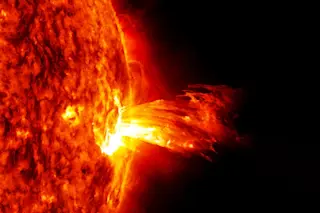I deal with superginormously ridiculous energies, velocities, and sizes all the time as an astronomer. You get used to it after a while... then something like this'll slap you upside the head: a star that exploded more than 5000 years ago launched two epic bullets. One is a cloud of gas screaming away at thousands of kilometers per second, and the other is the cinder of the star itself, an octillion-ton cannonball blasting through space in a totally different direction.
This is a composite picture of the supernova remnant N49: an expanding lumpy sphere of gas about 30 light years across (300 trillion kilometers, or 180 trillion miles)*, located in the Large Magellanic Cloud, a satellite galaxy to our Milky Way. The blue in the picture is the emission from gas heated to millions of degrees, and shows X-rays detected by the Chandra observatory. The yellow and purple are from ...













